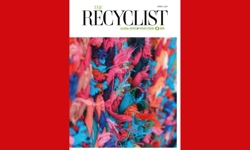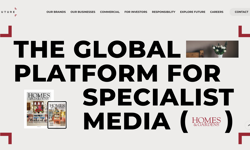You can get an idea of how long someone's worked in publishing by how they perceive UBM. To some, the owner of 170 year-old Building magazine is the newspaper publisher that switched from nationals to regionals then back to nationals again with the purchase of Express Newspapers in 1985. To others, it's the print specialist which, after selling the Express to Richard Desmond in 2000 and renaming itself United Business Media, became a data and events powerhouse. Today, known simply as UBM, the business is changing again following the recent offloading of a significant chunk of its data services business. Its aim? To build a new model of business-to-business publishing.
"Our view of what is content is changing fundamentally and what we are developing is a belief that what's valuable to the professional communities we serve is a hybrid of traditional journalism, data and - the new element for us and what I believe sets us apart - peer-to-peer learning," explains UBM Chief Content Officer, Adrian Barrick.
The starting point is that the professionals UBM serves know more about their subject than its journalists do. While this has always been the case, B2B journalists have traditionally been the primary intermediary between industry experts and their industry. But the explosion of digital - social media, especially - has given a voice to professionals requiring the B2B model to change. Which provided the context for two major internal reviews which helped pave the way for UBM's content strategy today.
Business review
The first, almost four years ago, was a review of UBM's print assets undertaken by Barrick in his previous role as Chief Executive of UBM Built Environment - the events, data and media solutions division that's home to construction, property and interiors brands including Property Week and Building magazine which he first joined as a journalist back in 1991.
"The company had already started to rationalise the print portfolio, but David Levin (UBM's CEO since 2005) wanted somebody to take an overview. So we reviewed every title, creating a score card system for each to assess the future for each brand, where they fitted into their community and whether their future lay within UBM or elsewhere," he explains.
Then, two years later, Barrick led a second review - of content - which, in effect, ended up providing the job description for his current role which he took up last November. "If you look back at the history of the company, we have been content-focused for the best part of 170 years - our oldest title is 170 years old - and it has been something that for all sorts of reasons we have taken for granted because we have always had journalists and publications. But we were looking at a world where we could no longer assume that would always be the case, and certainly not on the scale we'd been used to," he continues. "So it was important to stop and think how important is content to us, what is it, and how will we do it in the future in a way that's profitable and valuable for the business?"
The process consolidated UBM's philosophy that content - whether delivered via live events, digitally or (where still appropriate) in print - is what brings buyers and sellers together and that significant value and revenue can be created at the point where they meet.
So, today, UBM is focused around events, marketing services and PR Newswire (the global news distribution business it has owned since 1982) serving a portfolio of 70 broad professional groups ranging from fire and safety specialists through building and property developers to games designers and oncology nurses. Data still has an important role to play, but only the right sort of data most sought by those most willing to pay - one reason for UBM's recent disposal of a significant portfolio of health, technology, IP, trade and transport, and paper sector data services to private equity fund Electra Partners.
The services UBM now provides revolve around live events, digital content and - in some sectors, such as property - print products (though the company's best-known magazines, Building and Property Week, have evolved into cross-platform brands) and online communities with the mix varying according to the particular needs of each professional sector. Revenue streams vary by sector, too. For example, some audiences are served by sponsored sites while others have ad-supported digital products. All UBM services are cross-sold cross-platform, however, and the company is currently exploring online subscription and membership models for selected content.
The common strand throughout, though, is UBM's ability to integrate what it does at live events with what it does online, via mobile and social media to create what Barrick calls "a seamless organic conversation" with different groups of professionals. "What we are doing is creating platforms that help us fulfil our business objective of building communities," he adds. All of which has altered the job description of the journalists on which the business still depends.
The changing nature of B2B journalism
As an ex-journalist, Barrick insists he still believes in traditional journalism "vehemently" and that what journalists do - breaking stories, analysing events and data - is still valid today. It's just that with the commoditisation of news having a news division churning out stories is of diminishing value to customers so increasingly difficult to monetise. And besides, digital has made the role of the journalist far broader.
"The 300 word news story / 1,000 word feature approach to journalistic content is only 100 years or so old. But go back further and journalistic content was partisan, polemical and brimful of opinion and conflicting views," Barrick observes. And this is closer to how UBM now defines the journalistic content it seeks to produce - content ranging from articles and infographics to live debates, Twitter, video and Google Hangouts.
"Editors we now work with must be confident across all platforms - including video, live events and social media, and a good presenter," he adds. "Good relations with the community you serve are more important than ever as we spend more time finding and paying for online moderators and signing up people from different communities to write copy - which we pay properly for and edit, too, to ensure it is compelling enough to encourage other community members to contribute."
Small wonder UBM is now shy of calling itself a 'publisher' - a term which simply has too many out-dated connotations, Barrick explains. Marketing services provider is now the business's preferred descriptor with content the driving force that brings the professional buyers and sellers it serves together.
The company's community strategy is another approach the term 'publishing' struggles to convey. Don't mistake 'community' for just another word for 'audience', though. The former is, by definition, more deeply engaged and socially interactive.
Of the 70 or so main professional audiences that it serves, the company defines 45 as 'communities' - groups whose members, though individuals, share a clearly defined purpose and who are sufficiently active and engaged to want to interact with each other in depth to serve both their individual and group interests. A New York-based team set up to investigate, in depth, the best ways to create, manage and meet the best interests of professional communities came up with a set of principles and guidelines now used company-wide and known internally as 'Deus M'.
The aim is to build successful digital communities underpinned by behavioural analytics so UBM can observe and learn how those communities evolve over time rather than simply at an annual live event. "The value of integration is not just around pushing registrations to a trade show through a piece of online content, but understanding the constantly changing dynamics, which topics and experts are hot, and ensuring everything we put out - in magazines, online or at live events is topical and relevant," he explains.
As well as optimising UBM's presence in the communities it already serves, the company is also eager to enter new ones. "Generally, we would not launch (a community) in an environment where there is not already an event or where you can't already observe behaviour," Barrick continues. "What we look for is complexity and fragmentation - you need to see value in bringing together disparate groups, as was the case with a site we launched from scratch called Future Cities."
UBM already has a presence in the technology, built environment and security sectors. With its focus on meeting the challenges associated with sustainability and rapid urbanisation, Future Cities straddles all three. Another recent example is a community UBM launched last year for oncology nurses with commercial partner biopharmaceutical company Bristol-Myers which conducted a study late last year showing that as a result of information and experiences shared via the online community, participating nurses had improved cancer treatment for an estimated 365,000 patients.
Importance of measurability
Every content activity has to be measurable, though. UBM has extensive content output metrics - number of blogs each journalists writes, number of bloggers and moderators signed up per community, and so on to compare what content investment works where. It also pays close attention to community interaction - numbers of pages and stories viewed per reader, time spent on site, and number of messages posted. However, while many of these measures can be tracked in real time, Barrick points out, it is as important to give products time to establish themselves.
For UBM, then, the focus now is clear - though Barrick insists the strategy is constantly evolving. "Over the next few years, we will do a lot of learning, experimenting and honing of our model. We need to develop by building stronger mobile solutions, by getting better at video, and developing new analytics," he explains. "What we do have is a direction and a response to what's happening now and an understanding of how the communities we serve are evolving. But in an age of permanent disruption, no-one can afford to think they've a road map to the next few years."












